NEW Story: Cocktail
Canal Living

This article is not part of Vekllei canon. It may be old, obsolete or just a bit of fun.
✿ This article was featured in Issue #2 of the Atlantic Bulletin
Atlantic Salmon was the best in the world, and Vekllei had a lot of it. Ocean-going fishing boats brought their haul to Ro, where they cruised wide postwar canals and unloaded tonnes of shiny, bright salmon into processing plants. If a new factory was built, so too was a canal or a railroad. Nothing was trucked. Fish was traded fresh in markets or turned into emulsifiers and fertiliser.
The canals were worked heavily, and few fishing vessels were incorporated. The vast majority of Vekllei’s fishing fleet was owned by the people that worked them, trading with the Sea Office. From a quaisiosn or “canal park” you might see a dozen vessels in an hour. Some were run-down prewar things limping out to the shallow coasts, while others were nuclear-powered salmon trawlers designed for the storms of the Atlantic. On the northern coast, the bigger boats were reinforced as ice-breakers. Fish was one of the few meats in the Vekllei diet that wasn’t grown in an industrial laboratory, a fact reflected in the scale of its infrastructure.
Canals are good for a city, and are good for the heart. Tzipora would take long walks in the morning along the Wellington Canal to where it met Touismah, then follow it to where it circled back into Lola. She would figure out what she was doing with her life as the boats departed for the day’s catch. She never much liked salmon, but she liked the boats. They were an island country, and their futures and pasts met in the sea — where it churned and swelled in their dreams.

